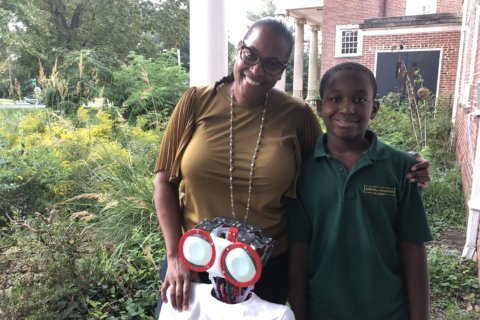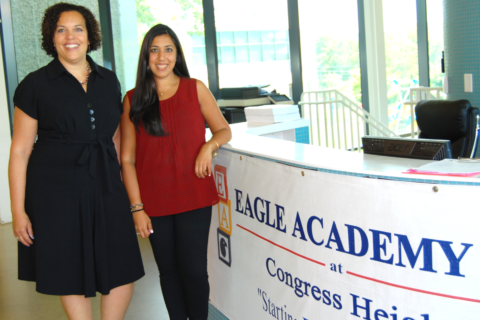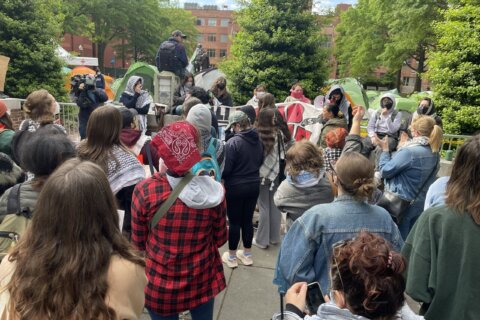WASHINGTON — For D.C. resident Alex Cournol, Feb. 25 was “Christmas,” 10 months early.
Monday morning, he learned that the charter school his 4-year-old twins attend in the Navy Yard neighborhood of Southeast D.C. would remain open next year.
Last week, he was fighting against its imminent closure.
Earlier this year, parents at Eagle Academy Public Charter School’s Capitol Riverfront campus were informed that the school’s 10-year run at its leased New Jersey Avenue location would end in June. The owners of the two-story building have plans to redevelop the space into multifamily residential housing — much like the newly constructed luxury condos and offices that surround it — and Eagle Academy wasn’t able to find an alternative for the 2019-2020 school year.
“Back in 2009, all these other buildings weren’t here. It was a neighborhood,” said Eagle Academy CEO and CFO Joe Smith, referring to the recently revitalized area near Nationals Park, where two-bedroom apartments now rent for more than $3,500 a month.
When Smith decided to open the charter school campus a decade ago, he said more people were moving to the area and the demand for a school was growing. Van Ness Elementary School, a D.C. public school in Navy Yard, was closed between 2006 and 2015, and even though charter schools run on a lottery system and do not guarantee neighborhood preference, Smith said it was a needed addition for those living close by and commuting to jobs in the area.
To this day, the Southeast neighborhood is one of the city’s fastest-growing districts — and construction continues.
But along with new places to live, new spaces to work and new restaurants galore, a redeveloped and increasingly populated Navy Yard has also ushered in higher property values, and that’s a growing problem for charter schools such as Eagle. Because even though public charter schools receive public funds to help offset operating costs, they are run by nonprofits and are responsible for securing and maintaining their own buildings.
“One of the most difficult things we (charter schools) have to do in the city is to find a location where we can operate,” said Smith, who knew about the building owners’ plans to redevelop and has been searching for a new home for the school for the last few years.
“We tried for several years to find a location here in Ward 6, but all of that had been purchased by developers on speculation, so that even when we looked at a bare strip of land or a building we could knock down, somebody else had already bought it.”
Last weekend, Paradigm Development Company, the owners of Eagle Academy’s Navy Yard building, let Smith know they could offer him an extension for the 2019-2020 school year.
“This is some of the best news we’ve had,” Smith said.
But it’s far from a permanent fix. For many public charter schools in D.C. and around the country, finding functional and affordable real estate is an ongoing struggle — and one Smith could face again in the near future.
***
Dominique Fortune with Building Hope, a nonprofit that helps charter schools find, finance and build facilities, said charter schools are now in a position where they have to compete for real estate on the commercial market.
D.C. currently has 123 public charter schools, and nearly 50 percent of D.C. students attend one, but facility affordability is becoming a growing problem among schools looking to open, expand or relocate — especially in areas “where real estate is skyrocketing.”
Fortune said there are a lot of schools in a similar position to the one Eagle faced earlier this year: “They’re not going to be able to afford to stay in the space that they’re in, but there isn’t really an alternative or any place for them to go,” she said.
Her Building Hope colleague, Jerry Zayets, said in many instances, what charter schools can afford to pay is below market value of the going rental price.
“So essentially, you need to convince someone that, ‘Hey, I’m going to put a tenant in the building that’s going to be loud, and there’s going to be noise and traffic and pickups and drop-offs. Oh, and I’m also going to pay you $12 less (per square foot) than market rent.’ That’s not a compelling argument to a commercial landlord,” Zayets explained.
To avoid taking on a mountain of debt with higher rents than what they can afford, Zayets said some schools opt to operate out of “subpar” spaces, such as older buildings or churches — “and they just do what they can.” However, this limits the successful schools from growing their programs and expanding their reach to more students.

Scott Pearson, executive director of the D.C. Public Charter School Board, has seen higher rents put pressure on schools in other ways, “like teacher salaries, extracurricular activities, and other services that a school provides.”
In the past, public charter schools were able to lease or occupy schools closed by the city, but Pearson said that hasn’t been the case in the last few years. So charter schools are having to look elsewhere and, in many instances, pay a lot more.
“It’s getting more expensive, plain and simple. And when you’re competing with a fixed-income real estate model, which is charter, compared to an escalating commercial model, there’s a gap,” Zayets said.
“So the question is, how do you fill the gap? Do you compromise your programming? Do you fundraise? Do you take on a crazy amount of debt? Or, you don’t expand.”
***
Eagle Academy is opening a new campus, its third, for the start of the 2019/2020 school year in Ward 8’s Fairlawn neighborhood, a site Smith said the school purchased a number of years ago.
“And thank goodness we did because we couldn’t buy it now,” Smith said.
Assuming the Capitol Riverfront campus would close, parents there were given the choice to send their children to Eagle’s new school, but many didn’t see that as a viable option.
Eagle Academy Principal Sabrina O’Gilvie said the majority of parents either live or work near the Riverfront campus, which educates about 150 students, and adding an additional 2-mile commute to a non-Metro accessible school poses a logistical nightmare.
“Our parents are desperate to keep us here … We just want a space where we can educate our children and be part of the community,” said Smith, who is hopeful the new lease extension will buy Eagle the time it needs to find and configure another space close by.
“That allows us to have another year to find a place where we can get a permanent location in Ward 6, in the same area we’re in. And I’m much more optimistic about getting that with the extra time,” he said.
In many cities, including D.C., schools aren’t limited to stand-alone structures; they share building space with law firms, coffee shops, churches and residents. But finding a floor or two of space that works for the landlord and the other tenants isn’t always easy. AppleTree Early Learning Public Charter School is one example. A few years ago, The Washington Post reported the school’s Columbia Heights campus received complaints from other building residents annoyed by noise from the school’s playground.
Stan Sloter, president of Paradigm Development Company, said Eagle has been a great tenant over the years, but including a charter school in one of his new Navy Yard projects isn’t necessarily an asset to the immediate community since, unlike traditional public schools, enrollment spaces at charter schools are not reserved for those in the neighborhood.
“If you put a charter school in one of your buildings, for example, you cannot tell your residents that they can go to it. So it’s great to put a charter school in a particular area, but because of a lottery system and so on for getting into the charter school, there’s no neighborhood preference for the kids who live in the building,” Sloter said.
“If we could have a neighborhood preference, meaning that the residents in a particular building or in a particular community would have a preference to go to the school, I think you’d find developers a lot more interested in trying to figure out a way to make these things work.”
D.C. Public Charter School Board’s Pearson said the Office of the Deputy Mayor for Education’s recent report on facilities had some “good suggestions” for the future of school space as enrollment both in public charter schools and the city’s public school system continues to grow.
One is to set aside space for future schools in “large pieces of property” that are planned for multiuse developments.
“This is common practice in other parts of the country. If you’re going to build hundreds of new houses in a particular area, you will set aside space for a school,” Pearson said. “In D.C., there’s historically been so many empty school buildings, at least for the last 40 or 50 years, that it hasn’t been an issue. But now, we are in a new era.”
Planning for long-term growth of the city’s school system is important; but planning for its immediate future is more pressing — especially to parents like Cournol, who worries he’ll be in the same position facing a school closure a year from now.
“We all love this city; we all love the fact that the city is moving toward a newer Washington, D.C., but we can’t move schools out of the city,” he said.
“It’s wrong; it’s not working and it’s just not fair to all the children in the District.”
Aaron Lentner, whose 7- and 3-year-old children attend Eagle’s Capitol Riverfront campus, said if there’s one thing he has learned this year, it’s that finding space for the school, and others like it, is a “solvable problem.”
“We as a community can solve this problem, and we have the time to solve it now. And I have not met or talked with anyone who doesn’t see the obvious nature of it not being in the community’s best interest to move a well-performing school out of this area, so I’m hopeful we can all wake up and do the right thing,” he said.
“Hopefully somebody can take the long view.”







